With embedded sounds by Dan Dugan, Sharon Perry, and Bernie Krause.
Sharon Perry and her husband, Dan Dugan, inhabit a converted warehouse with double walls to keep out the racket from a neighborhood wedged between Interstate 280 and Highway 101 in San Francisco. Today, on the pavement outside their living and work space, I don’t hear a bird chirp or tweet, but inside it’s another world. Perry and Dugan have a vast digital library of birdsong they’ve recorded across Northern California. At any time of day or night they can press a button and transform their stark urban environment into a rich auditory habitat.
Right now they’re higher than kites. They’ve just returned from an expedition to a marsh in the Sierra Nevada where they taped cranes, ibises, pelicans, and snipes. Perry and Dugan didn’t spy a single snipe — a bird that usually perches invisibly among reeds — but they heard them. “The snipe makes an amazing winnowing sound,” Dugan tells me. “It came out of nowhere. We heard a snipe solo and then a whole orchestra of birds.” Dugan pressed a button and turned up the volume; instantly, I felt transported to a wild marsh.
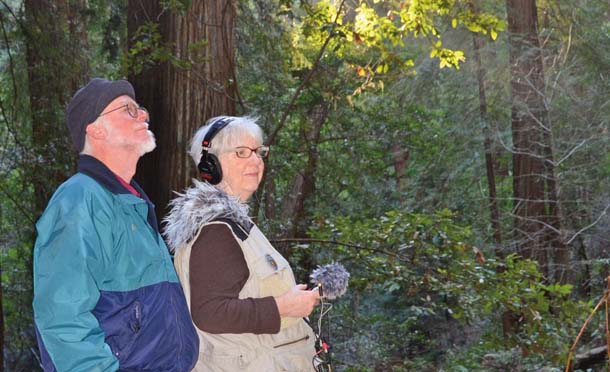
Tried-and-true members of the Nature Sounds Society, Perry and Dugan are near the heart of the fast-growing field of acoustic ecology which studies the relationships between sounds, species, and geographical spaces. Acoustic ecologists listen to the “geophony”— the rumblings and grumblings of the earth itself including wind and rain — and the “biophony,” the cries and whispers made by living creatures, from whales and wolves to crickets and birds. A third key term, “anthrophony,” refers to the sounds made by human beings and their machines such as airplanes, refrigerators, and air conditioners. Naturalists who study the geophony and the biophony — acoustic ecologists — draw “acoustic maps,” charting and measuring local and global “soundscapes.” They rely, of course, on ears, an organ that has played second fiddle to human eyes for too long, especially when it comes to the environment. So Nature Sounds Society members insist.
R. Murray Schafer, a Canadian musician and the father of acoustic ecology, conducted the first soundscape studies in the late 1960s, though earlier scientific recordings of nature were made by the British in the 1930s and released on Gramophone Records. For decades, Schafer has called for the preservation of “soundmarks,” the aural equivalent of landmarks. With his colleagues at the World Soundscape Project he has systematically taped the sounds of the planet, starting in British Columbia and moving farther afield.
Like many members of the Nature Sounds Society, Perry and Dugan come to acoustic ecology from different, though not antithetical, ways of operating in the world. Dugan is an engineer, inventor, and technological wiz who designed the microphones used on TV by David Letterman and by professional sports broadcasters. Perry is a naturalist and environmental educator. For years, she led workshops to show kids and adults how to listen to nature and be aware of the sounds they heard. Perry enjoyed the work. She also found it challenging to persuade the young and the old alike to sit still and tune in.
“The Nature Sounds Society reaches out to artists and scientists,” Perry tells me. “We’re creating a nexus where artists can appreciate the science of sound and scientists can appreciate the art of sound. We want birders with binoculars and sharp eyes to share their lore and skills with engineers equipped with recording devices and trained ears, and vice versa.”
During their weekend in the Sierra, Perry, Dugan, and their colleagues attended a talk by Bernie Krause, whose book The Great Animal Orchestra (2012) sums up a lifetime of global soundscape exploration. Perhaps more than anyone else in the country, Krause popularizes the seminal ideas at the heart of acoustic ecology: that animals communicate, through sounds, with one another; that they’re largely cooperative rather than competitive — after all, they harmonize; and that the animal orchestra has fewer members now than it once had because of environmental degradation and habitat loss. Moreover, Krause insists on recording a whole ecosystem, not just one species of bird or frog. He wants all of us to understand how all the sonic pieces fit together to create an entire soundscape, which is more than just an array of random noises.
A keen listener — whether at Mono Lake, in the Amazon, or in his own backyard — Krause has recorded birds and beasts howling, hooting, humming, bleating, cackling, and more. His passion for sounds is infectious and he has turned inventors like Dan Dugan into naturalists. “I was a techie,” Dugan told me. “I’ve become a birder.”
For years, I’ve played over and over again the CD Krause recorded in Borneo that includes the pitter-patter of rain that seems to be falling on my roof, especially when I listen in the dark. I also enjoy his CD of the more familiar but no less intriguing sounds of the early morning bird chorus — tweets, chirps, and warblings — at Sugarloaf Ridge State Park near his home in Sonoma County. On a recent visit I made to interview Krause and view his recording studio, we lounged on the deck. I couldn’t see a single bird, but he was able to identify all the birds by their songs and calls: “That’s a hungry crow. That’s a robin looking for a mate and that’s a pileated woodpecker.”
Here’s a recording he’s done of insect larvae and spadefoot toad tadpoles:
And another of Pacific chorus frogs:
Born in Detroit in 1938, Krause fell in love with the sounds of frogs, crickets, and birds when he was a boy. A folksinger and a skilled guitar player, he joined the Weavers and toured with the group after Pete Seeger departed. Krause went on to study electronic music at Mills College in Oakland. In the 1960s, he teamed up with Paul Beaver to create electronic music for well-known rock musicians such as the Byrds and George Harrison and to make soundscapes for movies such as Rosemary’s Baby and Apocalypse Now. These days, Krause still enjoys the Beatles and the symphonies of American composer Charles Ives, though the melodies he longs to hear most come from nature itself. If everyone turned off cell phones and went into the woods to listen acutely he’d be in heaven.
On his deck, with birds chirping and tweeting in the background, he tells me that the trouble began in the Middle Ages when “they built churches to keep out the sounds of nature, and later with the Renaissance that elevated the visual and downgraded the auditory.”
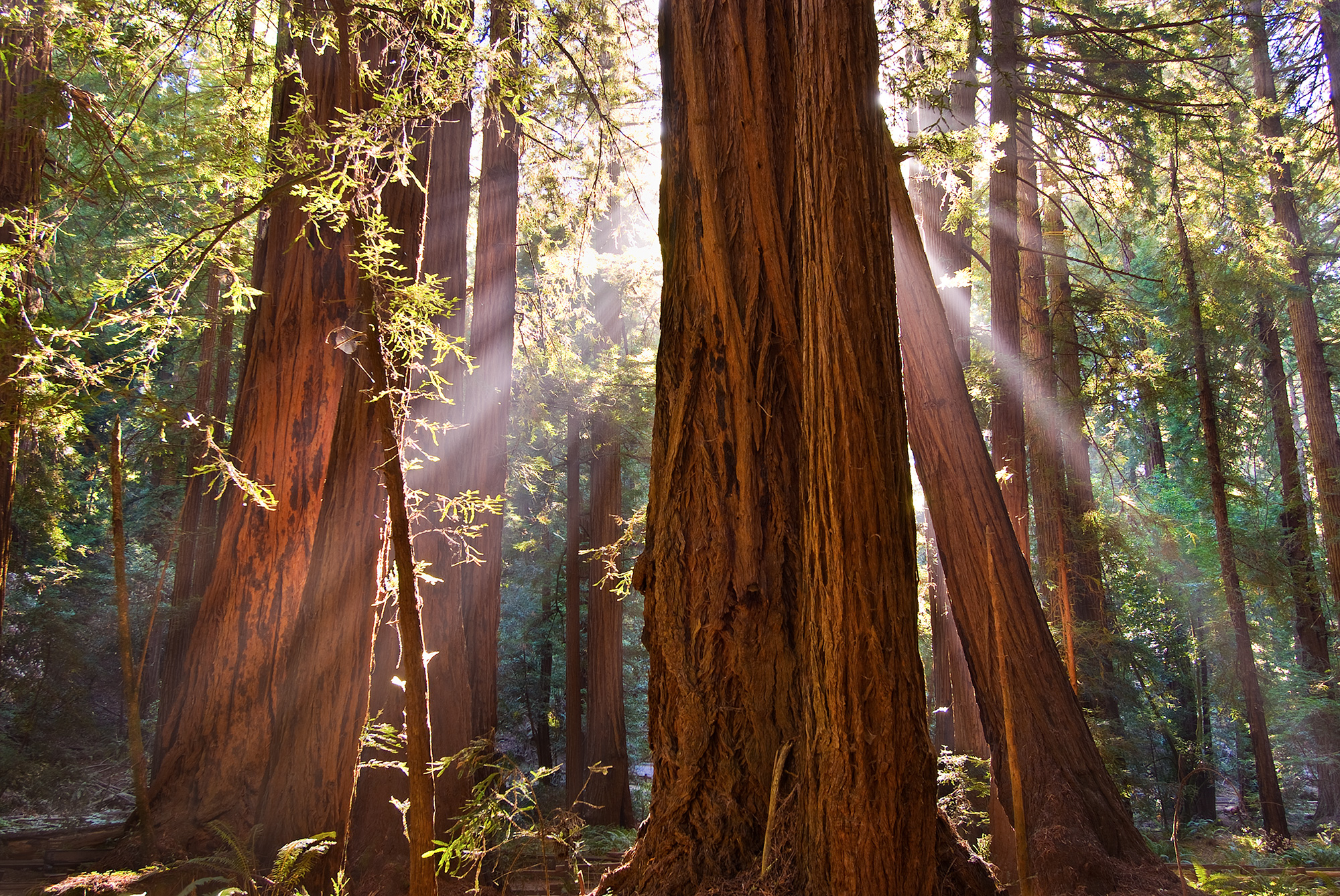
Krause has a message for almost everyone he meets: Buy a recording device and tape the sounds of the earth and its creatures, especially at sunrise when birds perform the dawn chorus, or after sunset when crickets in a healthy environment can create a symphony of sound. “A camera is a device that teaches you to see,” he explains. “A recorder is a device that teaches you to hear.”
He and Beaver made their first recordings of nature at Muir Woods. For their 1970 album In a Wild Sanctuary, they synthesized the sounds of the woods with the rhythms of jazz orchestras and the melodies of electronic music to produce a cultural hybrid that wasn’t purely natural or entirely man-made either. Increasingly, Krause became aware of the gaps and the silences in the soundscapes when he listened to them with earphones. “Hearing with earphones is similar to seeing the world for the first time through really awesome binoculars,” he tells me. “Earphones both amplify and level out the sources of sounds.”
These days, when he looks back at his career, he’s especially proud of the digital recordings he began to make decades ago that provide clear evidence of the environmental devastation caused by the industrial harvesting of timber. In 1988, a logging company gave him permission to record the sounds at Lincoln Meadow in Yuba Pass both before and after tracts of forest were cleared. Krause’s first recordings captured a rich biophony: woodpeckers, quail, sparrows, and insects, along with the gurgling of a nearby stream. A year later, at the completion of the logging operation, he returned to Lincoln Meadow and set up his equipment again. Those recordings, made with fully functioning, top-of-the line digital equipment, captured only the sounds of a lone woodpecker and the stream.

Over the next 20 years. Krause returned to Lincoln Meadow to record a dozen times. Using standards set by researchers at Michigan State University, he analyzed and interpreted the data he gathered and found that the total numbers of vocal organisms at the site dropped by about 80 percent. The total number of species declined by 40 percent. Logging at Lincoln Meadow had led to a soundscape that was far less diverse and far too quiet.
Krause has inspired a generation of ecologists and naturalists, though he hasn’t been the only one to play a significant role. Others include Dick Hingson, Paul Matzner, and Gordon Hempton. The Sierra Club has also called for quiet on a national level. All around the country, activists have worked for decades to protect the sounds of nature. In 1972, in response to lobbying by environmentalists, Congress passed the Noise Control Act, which required the federal government to regulate sounds — including those from noxious snowmobiles and airplane overflights — in national parks. That bill lost its funding in 1981, but in response to scientific evidence and citizens’ groups, the National Park Service formulated its own rules and, in 2002, created the Natural Sounds Program. World Listening Day, which the NPS endorsed, took place for the first time in 2010. Like trees, streams, and mountains, soundscapes were now officially recognized as entities to be protected, nurtured, and revered.
The NPS selected Muir Woods as one of the pilot sites for its soundscape studies. Paul Matzner at the Oakland Museum Library of Natural Sounds recommended Dan Dugan and Sharon Perry for the job. Once a month for a whole year, they traveled from San Francisco to the park at the end of the day with equipment in tow. They spent the night in the library at the education center at Muir and rose before sunrise to record the dawn chorus. They also recorded in the dark and captured the hoots, and more, of four different kinds of owls: barred, saw-whet, great horned, and northern spotted (which are endangered). Dugan and Perry also learned there were more birds — including band-tailed pigeons and winter wrens — to be heard in the nearby mixed oak, madrone, and Douglas fir forest than in the stands of old-growth redwoods, which tend to muffle sounds and don’t offer as diverse a food supply.
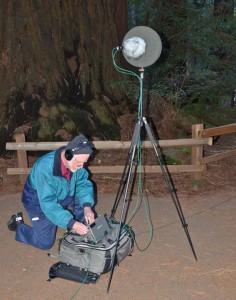
Furthermore, Dugan and Perry enlisted volunteers to wander about the park during the day and keep lists of human-made noises: blaring radios, the clicking of cameras, and the rings of cell phones. The data and analysis led the Park Service to adopt significant noise-reduction measures, such as moving the parking lot away from the forest itself, eliminating the clanging of cash drawers, and effacing the noise of ice machines. Thanks to these changes, visitors can now hear, without interference, the silence of Muir Woods — one of its primary attractions. Signs at the entrance and at Cathedral Grove, the park’s “spiritual heart”— in Dugan’s words — call for quiet: no talking, no snapping of photos, and no ringing cell phones.
Last December during the solstice, Dugan set up a table where visitors could wear headphones and listen to Muir Wood’s soundscapes. They could also see on display a recording vest with microphones on the shoulders and a recorder in the pocket; it made acoustic technology seem fun. “It was raining hard,” Dugan tells me. “But Muir has fierce fans and the rain didn’t stop anyone from showing up and putting on the headphones. My wife Sharon calls it ‘listening with bionic ears.’ ”
Dugan pauses and tells me about a sign he recently saw in Hawaii that he’d like to see in Muir. It read: “Quiet, Trees at Work.”
Probably no one knows the soundscapes of Muir Woods more intimately than Mia Monroe, the renowned park ranger and site supervisor who has worked there for 35 years. Monroe led the charge to help create an environment in which the endangered spotted owls can sleep and mate without interference from loud noises, and in which visitors from all over the world can actually hear the redwood forest. A graduate of the forestry program at UC Berkeley and a naturalist who has learned from Krause, Dugan, and Perry, Monroe describes Muir Woods as “a habitat where humans hear the creaking of trees, the whispering of the wind, the babbling of Redwood Creek, and the very heartbeat of Earth itself.”
“Muir Woods provides a haven from the racket of civilization,” Monroe tells me. “The fact that it’s so close to a boisterous urban environment makes it all the more special. After 35 years, it still moves me in wonderful ways.”
Michael Stocker has been listening to the wonders of nature nearly all his life. A bioacoustician and a jazz musician who worked on the movie Koyaanisqatsi (the 1982 visual tone poem scored by Philip Glass), he’s spent much of his career studying ocean sounds, though he also monitors ecological niches on land, including his own niche in Marin County’s San Geronimo Valley, not far from the protected soundscape at Muir Woods.
The founder, in 2007, of Ocean Conservation Research, Stocker has long insisted that if we want to save the earth we must also save the seas. When the U.S. Navy announced plans to conduct tests of low-frequency sonar in the name of national security, he complained as politely though as passionately as he could that the tests would disrupt the sonic environment in which whales and other marine mammals communicate across vast distances. “Ensonifying the seas,” he tells me, “was bound to disrupt the underwater life of blue and gray whales. It wasn’t fair to them and I don’t think it did much to improve the security of the nation, either.”
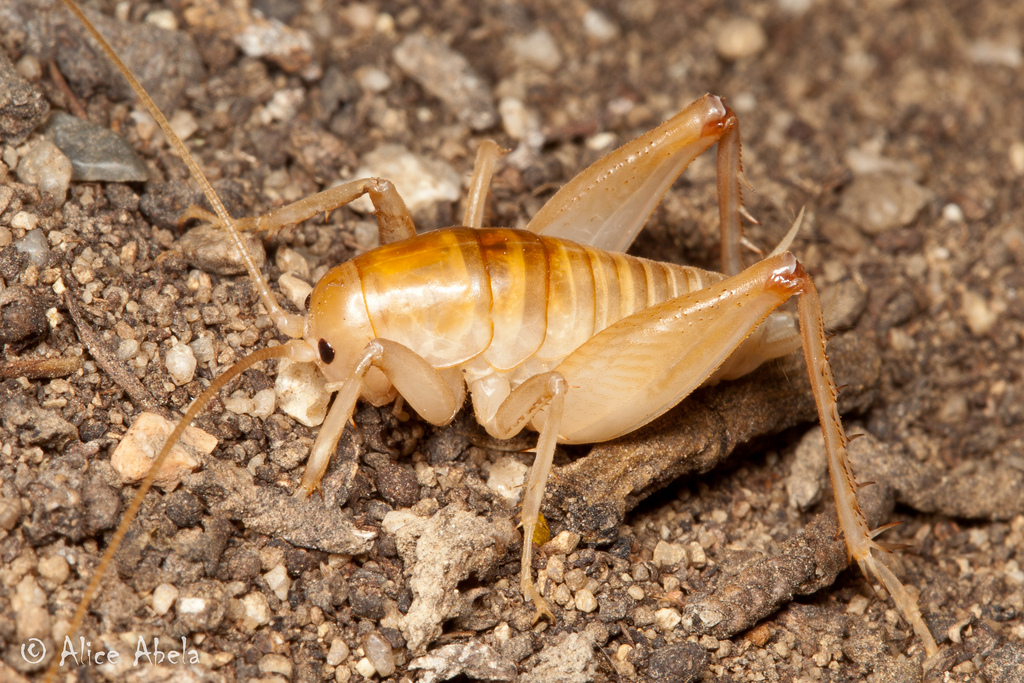
Now, close to home, he worries about the life and death of crickets, a creature that has a long history of coevolution with human beings. A hearth with a chirping cricket is said to be a sign of a healthy home — ask the Japanese, read Emily Dickinson and Charles Dickens, or talk to Michael Stocker. According to scientists, the number of chirps per second can help provide an accurate reading of air temperature. Once upon a time, Stocker’s own backyard throbbed with crickets. Now it’s silent. “On summer nights over the last five years,” he explains, “I’ve noticed there’s not a single cricket chirping in the whole of the San Geronimo Valley. It’s not just one species, but all the many different kinds of crickets. I know. I’ve traveled the length and breadth of the valley on bicycle and listened carefully. A world without crickets gives me the creeps.”
He believes that the absence of chirping crickets — and other “holes in the acoustic niche”— are the result of colder winters and hotter summers. Unable to adapt to these climatic changes, the San Geronimo Valley crickets may have become largely extinct.
After meeting with Stocker, I did additional research and learned that citizens in dozens of locations around the country have made the same or very similar observations, reporting “silent summers” when no crickets chirped.
In his forthcoming book, Hear Where We Are, which is part sociology and part natural science, Stocker explores the ways animals communicate with one another and with members of other species. Hear Where We Are offers compelling facts and figures. It also appeals to basic human emotions. In one of the book’s most evocative sections, Stocker writes about a woman in Borneo who says, “We yearn for the sounds of the forest. We have always heard these sounds. And now it’s harder for us because we hear the sounds of the bulldozers.”
Like her, Stocker yearns for the sounds of his own ecosphere beyond the roar of cars and the blasts of machines. “Today, the challenge for acoustic environmentalists is to remain optimistic in the midst of unprecedented noise and clutter and in the wake of devastating weather systems that are almost certainly the result of humans messing with the earth,” he tells me.
Along with Bernie Krause, Dan Dugan, Sharon Perry, and Mia Monroe, Stocker persuaded me in his own subtle way to listen to nature more carefully than I’ve ever listened before. Meeting members of the dedicated tribe of acoustic ecologists has prompted me to slow down and listen to all the many diverse voices of the natural world around me. Now, in my own backyard, I tune in to the songs of robins, the rhythmic beating of the wings of hawks, and the croaking — rok-rok — of herons. I hear the meandering creek, the wind in the oak trees, and the scampering of ground squirrels. Thanks to groups like the Nature Sounds Society and Dugan’s and Perry’s research at Muir Woods, the slogan “Quiet, Trees at Work” will perhaps become an environmental rallying cry around the world. I’d like to see — and hear — that day.
Jonah Raskin is the author of Field Days: A Year of Farming, Eating, and Drinking Wine in California and a professor emeritus at Sonoma State University, where he taught law and writing for 30 years.



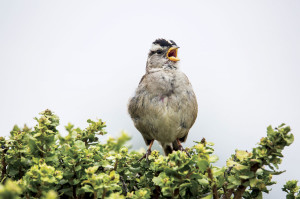
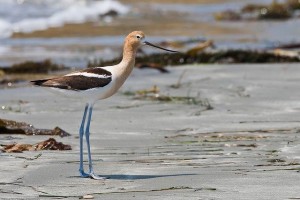
-300x238.jpg)